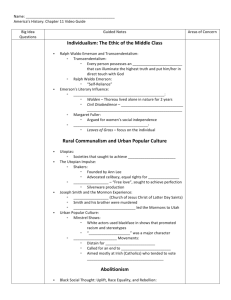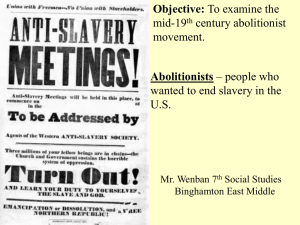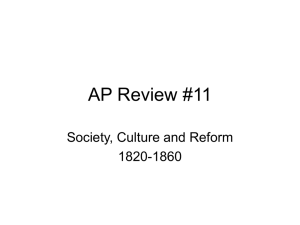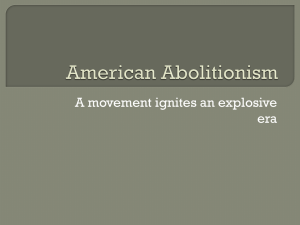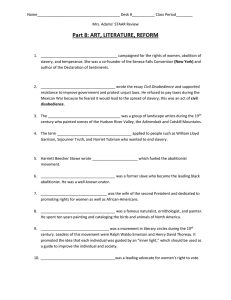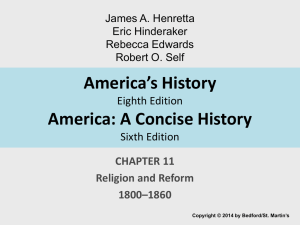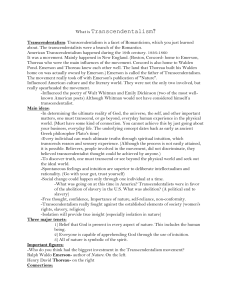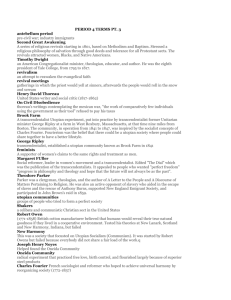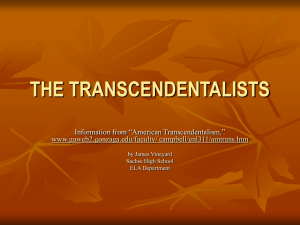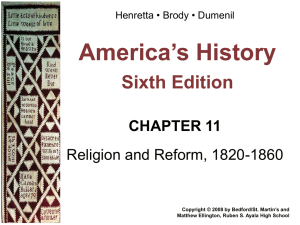America`s History Chapter 11
advertisement
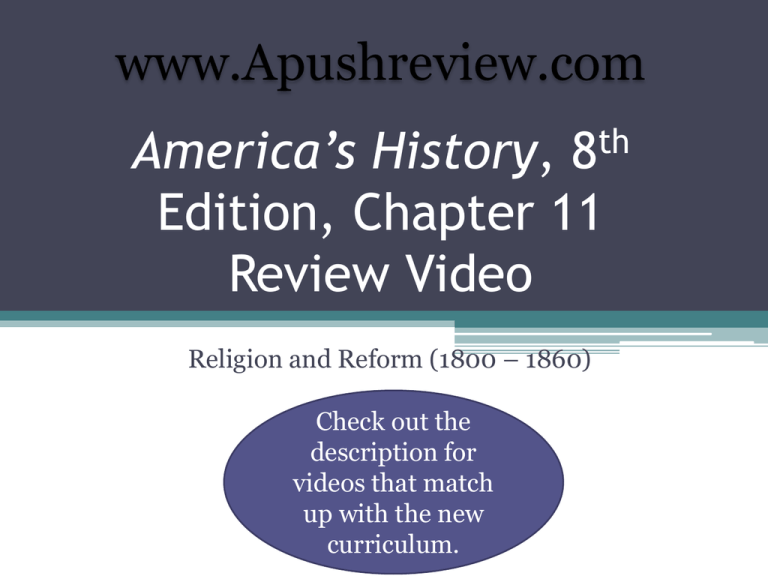
www.Apushreview.com th 8 America’s History, Edition, Chapter 11 Review Video Religion and Reform (1800 – 1860) Check out the description for videos that match up with the new curriculum. Individualism: The Ethic of the Middle Class • Ralph Waldo Emerson and Transcendentalism: ▫ Transcendentalism: Every person possesses an inner light that can illuminate the highest truth and put him/her in direct touch with God ▫ Ralph Waldo Emerson: “Self-Reliance” • Emerson’s Literary Influence: ▫ Henry David Thoreau: Walden – Thoreau lived alone in nature for 2 years Civil Disobedience – urged individuals to resist unjust laws ▫ Margaret Fuller: Argued for women’s social independence ▫ Walt Whitman: Leaves of Grass – focus on the individual Rural Communalism and Urban Popular Culture • Utopias: ▫ Societies that sought to achieve perfection • The Utopian Impulse: ▫ Shakers: Founded by Ann Lee Advocated celibacy, equal rights for women ▫ Oneida – “Free love”, sought to achieve perfection Silverware production • Joseph Smith and the Mormon Experience: ▫ Mormons (Church of Jesus Christ of Latter Day Saints) ▫ Smith and his brother were murdered ▫ Brigham Young led the Mormons to Utah Rural Communalism and Urban Popular Culture • Urban Popular Culture: ▫ Minstrel Shows: White actors used blackface in shows that promoted racism and stereotypes “Jim Crow” was a major character ▫ Nativist Movements: Distain for immigrants Called for an end to immigration Aimed mostly at Irish (Catholics) who tended to vote Democrat Abolitionism • Black Social Thought: Uplift, Race Equality, and Rebellion: ▫ David Walker: An Appeal… to the Colored Citizens of the World Advocated violence to end slavery ▫ Nat Turner’s Rebellion (1831): Claimed to have revelations from Jesus Rebellion in VA that killed 55 whites 60 blacks, including Turner, were killed in retaliation As with all rebellions, slave laws became more harsh • Evangelical Abolitionism: ▫ ***William Lloyd Garrison:*** Radical abolitionist (for his time) Published The Liberator – immediate and uncompensated end to slavery ▫ The American Anti-Slavery Society: Founded by Garrison and Theodore Weld Helped show the violence of slavery ▫ Underground RR: 1,000 slaves a year – Harriet Tubman Abolitionism • Opposition and Internal Conflict: ▫ Abolitionists were few in number ▫ Many in the North benefitted from slavery (textile manufacturers, hog farmers) ▫ Amalgamation: Many whites opposed the intermarriage of whites and blacks ▫ Elijah Lovejoy: Murdered in Illinois, outspoken abolitionist and editor of newspaper ▫ Gag Rule – All anti-slavery petitions in the House would not be discussed; later overturned by JQA • The abolitionist movement split over women’s rights ▫ Garrison’s American Anti-Slavery Society supported women’s rights The Women’s Rights Movement • Women played a large role in trying to reform American Society • Origins of the Women’s Movement: ▫ Separate Sphere – expectation that women had different roles in society ▫ Dorothea Dix – mental health reform ▫ Horace Mann – “Father of Education” Tax-Supported elementary schools Schools in the South and West were inferior to the North • From Black Rights to Women’s Rights: ▫ Uncle Tom’s Cabin: Harriet Beecher Stowe – portrayed the evils of slavery ▫ Seneca Falls Convention: Elizabeth Cady Stanton and Lucretia Mott Declaration of Sentiments – “All men and women are created equal” Quick Review • • • • • • • • • Transcendentalism Henry David Thoreau Minstrel Shows Nativism Nat Turner’s Rebellion William Lloyd Garrison Abolitionist Movement split over women’s rights Dorothea Dix Seneca Falls Convention Thanks for watching! • • • • Good luck on your tests Check out videos matching the new curriculum Spread the word You can thank me Subscribe for getting your education….
